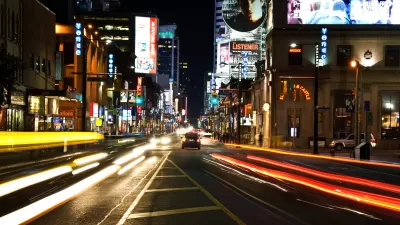“Despite long ago having fallen from favour among North American city planners and traffic engineers, the multi-lane, multi-use, tree-lined avenue will soon return to our fair burg,” writes Christopher Hume.
Thanks to Waterfront Toronto, the tripartite agency responsible for the transformation of Queens Quay, “[w]hat’s now a messy and dysfunctional downtown thoroughfare will become an elegant street shared equally by cars, public transit, pedestrians, cyclists — and trees,” reports Hume. The project has been in the pipeline for years, but is finally breaking ground and will be under-construction for at least two years. “From a larger civic perspective, the transformation is also a milestone” asserts Hume, stating that “[s]ince the 1930s, traffic engineers have avoided boulevards because they are thought to be at odds with their preferred 'functional' approach.”
Dutch landscape architect, Adriaan Geuze, who’s firm West 8 won the international redesign competition for Queens Quay in 2006, will transform what he refers to as “the waterfront boulevard” in Toronto, from an "dangerous" place full of potential and in dire need of improvement, to one that is still bustling, but friendlier for all users. “In North America,” Geuze says, “people are totally dependent on the car. So they’re used to the car being prioritized. We’re not against cars, but we do want to make more space for pedestrians and cyclists. We want transit to be totally integrated. We want pedestrians to hang around. We have to live together. These things should be celebrated.”
“Though Queens Quay won't become a boulevard in the classic sense, it will look and act like a boulevard. There will be two traffic lanes, down from four, and the remaining space will be given to bicycles, streetcars, walkways and several rows of trees.” writes Hume. He lauds Toronto for not shying away from complexity in its land use policies, but instead embracing it, something he sees as critical as thc city continues to grow.
FULL STORY: A boulevard runs through it: the Queens Quay remake

Alabama: Trump Terminates Settlements for Black Communities Harmed By Raw Sewage
Trump deemed the landmark civil rights agreement “illegal DEI and environmental justice policy.”

Study: Maui’s Plan to Convert Vacation Rentals to Long-Term Housing Could Cause Nearly $1 Billion Economic Loss
The plan would reduce visitor accommodation by 25% resulting in 1,900 jobs lost.

Planetizen Federal Action Tracker
A weekly monitor of how Trump’s orders and actions are impacting planners and planning in America.

Wind Energy on the Rise Despite Federal Policy Reversal
The Trump administration is revoking federal support for renewable energy, but demand for new projects continues unabated.

Passengers Flock to Caltrain After Electrification
The new electric trains are running faster and more reliably, leading to strong ridership growth on the Bay Area rail system.

Texas Churches Rally Behind ‘Yes in God’s Back Yard’ Legislation
Religious leaders want the state to reduce zoning regulations to streamline leasing church-owned land to housing developers.
Urban Design for Planners 1: Software Tools
This six-course series explores essential urban design concepts using open source software and equips planners with the tools they need to participate fully in the urban design process.
Planning for Universal Design
Learn the tools for implementing Universal Design in planning regulations.
Caltrans
Smith Gee Studio
Institute for Housing and Urban Development Studies (IHS)
City of Grandview
Harvard GSD Executive Education
Toledo-Lucas County Plan Commissions
Salt Lake City
NYU Wagner Graduate School of Public Service



























